In my time in the SCA, I have developed just one tiny pet peeve. One could call it a passion even. “What bee’s gotten into your bonnet?” you may ask. Well, it’s simply that I believe we should all be covering our heads when dressed in European garb.
Men and women have regularly covered their heads in public since recorded history, this tradition ending only recently in the late ’60s. Whether heads were covered to protect against the elements, for humility or modesty, or for fashion, there’s no doubt in my mind that a hat makes the SCA outfit. If I could influence just one thing, it would be to encourage more people to cover their heads at events.
To do a review of all hats over the course of history would be a lifetime’s work, so I’ll start with my interest — 16th century Germany. Even that maybe a bit broad, so let’s narrow it down to the first half of the 16th century, with an emphasis on the German upper class and the Landsknecht who both wore a great variety of headcoverings, from simple to elaborate. Here are the categories of haube (headcoverings) I’ve observed from period woodcuts and paintings:

Three different types of headcoverings are depicted in this one woodcut of a tross (Landsknecht army train). From The German Single Leaf Woodcut 1500-1550 by Max Geisberg; rev. and edited by Walter L. Strauss
Bundhaube (coifs/arming caps)
Stuchlein and wulsthaube (scarves and support caps)
Beretts (round caps with brims)
Gugel/Kogel/Kugel (hoods) – very few of these!
Gebende (headwrap with chin strap)
Goldhaube and Haarhauben (hair caps/cauls)
Haarband (black headband, used mostly by young woman of the lower classes)
Helm (helmets)
This is by no means an exhaustive representation of German headwear, but I believe it is a reasonable representation of the images available.
Resources:
http://www.historiclife.com/pdf/landsknechthatandcoif.pdf
http://scagermanrenaissance.blogspot.com/2011/08/lost-and-found-updated.html
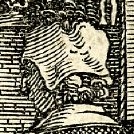
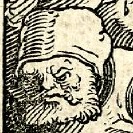






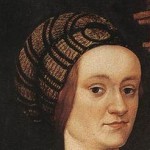
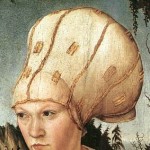

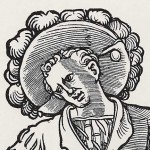
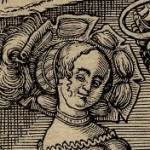
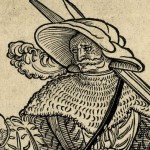
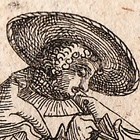
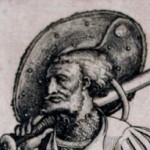






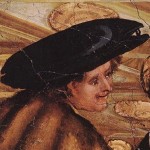
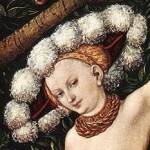
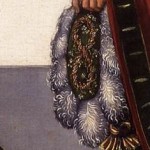


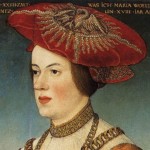




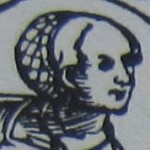
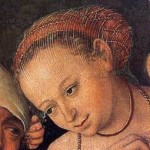
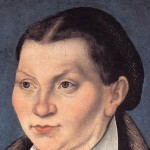

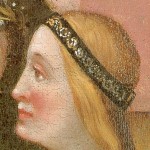
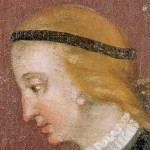


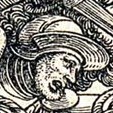

I rather suspect that the headbands were also worn under the coifs and scarves; they really make a handy anchor point for other headgear. Just guessin’ of course.
Yes, that would make sense. The German women like to braid their hair (topic for another post) and the band would serve to hold the braids in place as well as anchor more headgear. I have not seen a black headband peeking out from any of the more elaborate headgear, however. But if it isn’t meant to be seen, painters likely wouldn’t have painted it!
Hi there. A good and handy article. Indeed so much variety there. In the case of Gugeln I disagree though. When we look at the pictures we have to keep in mind, that certain convestions of how to construct a picture have to be kept in mind. We do see Gugeln quite regularly and that is in peasants/hunters and riders and the like.
All in all you seldomnly see cold/badweather gear all in all in the pictoral sources you refer to here. That can be for two reasons. It hasn´t been worn which is unlikely or simply wasn´t shown due to other reason, e.g. the aforementioned pictureconventions of the time. I suspect the latter. Although we see much truth in the pictoral sources available to us, we always have to be very critical and check with every image anew how far we can use it.
Thank you, Hendrik! Gugeln (hoods) are likely rarely seen in paintings because so many paintings are of portraits of the upper class. I was simply unable find many hoods — I imagine they were worn, just like coats and cloaks. I agree that we rarely see cold weather clothing in the images because they likely did not want to be painted with them on. Hoods, fur hats, cloaks, and cats are bulky and hide a person. I did find evidence of fur hats and fur gollers on women, though, which is something I’d been searching for for nearly a year — you can see it here: http://germanrenaissance.net/did-16th-century-german-women-wear-fur/
And yes, without a doubt, we must always be critical. Not everything is as it appears!
You´re welcome. 🙂
A hint to that Hoods and the like were worn by upper class are for example the Theuerdank iirc, where Max I. is riding around in them or the Matthäus schwarz biogrphy where he is depicted in such riding gear at least in young years. Need to check at home again. When you look at the Augsburger Monatsbilder, posh people are not depicted in too many cold wethaer gear there too despite being winter. So graphic conventions probably again.
All this reminds me of having to have a look at the sources again. Haven´t done so for too long a time it seems. 🙂 Keep up the good work!
Hear, Hear! I get really bugged when people spend time & money to get the correct look to their costume Yet wear no head covering, & even worse they have a very modern hair style, not to mention really funky hair colors. And worse yet is royalty that only wear a crown with no attempt to dress their hair in a period fashion. Yech, they are a visual represention of the SCA as a whole and there fore they should step it up! Cate